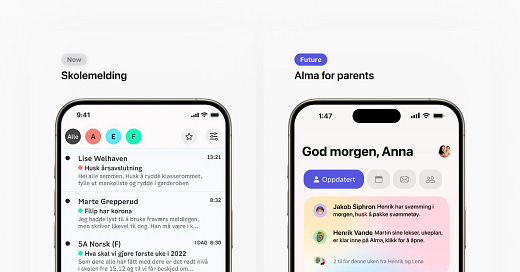The Daily Reality
I know a teacher whose workday is hijacked by parent messages. Watching her navigate this chaos looks like context switching warfare—and she's losing.
Every morning brings a flood of demands: "Why didn't X get her spelling test back?" "Can you explain Y's math homework?" "I'm concerned about the class field trip." Each message fragments her attention, pulling her from teaching and lesson planning into reactive customer service.
This isn't an isolated case. It's the hidden epidemic crushing teachers across grade schools, where communication has become key energy drainers.
Parents aren’t immune to these frustrations either—one likens the information flow to an archaeological dig:
“And don’t get me started on the parent apps we’ve been forced to use over the past ten years. The cup ran over long ago: log in with BankID, hunt down the inbox where teachers post the weekly plan, open the message, click the link, open the PDF in a separate app. Then repeat the exact same maneuver in the morning rush to figure out whether your child’s outdoor school day is today or tomorrow. But of course the app won’t work then—too much parent traffic! Well, there you go.
IT was supposed to be a help. This is a hindrance.” — Steinar Stølann on Linkedin
The Technology Trap
Here’s the paradox: schools have more ways to communicate than ever—and yet, communication has never felt this broken.
Teachers juggle email, parent portals, messaging apps, and printed notes home. Parents ping different channels for different teachers, creating a communication maze that exhausts everyone involved. One teacher uses email exclusively, another only responds through the student portal, a third prefers phone calls.
The result? Information chaos that would make customer service managers run.
Consider this scenario: A parent wants to know if their child needs swimming gear for Thursday's class. They check the class website (outdated), search through email threads (buried under 47 other messages), text another parent (who's also confused), then finally email the teacher directly (adding to the teacher's overwhelming inbox).
The teacher, already handling 14 other similar queries, crafts yet another individual response while mentally noting that she really should update the class website but doesn't have time because she's answering emails about swimming gear.
Why Previous Solutions Failed
EdTech companies have thrown countless "solutions" at this problem—parent portals, messaging platforms, automated notifications. Most gather digital dust because they:
Add complexity instead of removing it (one more platform to check)
Ignore the human element (sterile, impersonal interfaces)
Require manual input (teachers still doing all the work)
Fragment communication further (information scattered across even more places)
The fundamental flaw in these approaches? They assume teachers have unlimited time to manage multiple systems and manually input information that should flow automatically.
The Remarkable Alternative
What if communication could be proactive instead of reactive? What if routine information flowed automatically while preserving the human touch for meaningful conversations?
Here's how this transformation works in practice:
Instead of: A parent emailing "Does Henrik need swimming gear Thursday?"
Imagine: Parents automatically receive contextual reminders: "Henrik has swimming Thursday—gear checklist attached. He's been improving his backstroke technique!"
Instead of: Teachers manually responding to 14 individual scheduling questions
Imagine: An AI assistant that understands the classroom, schedule and sends relevant information before parents even ask
Instead of: Fragmented conversations across multiple platforms
Imagine: A unified communication hub that learns family preferences and adapts accordingly
How This Actually Works
The system we're building operates on three principles:
1. Context-Aware Communication The AI understands classroom schedules, individual student needs like certain reminders, and family communication preferences like language. It proactively shares relevant information rather than waiting for parents to hunt for it.
2. Teacher-Approved Automation
Teachers maintain control over messaging while the AI handles routine logistics. No message goes out without teacher green-light, but teachers don't waste time crafting basic informational updates, 20 times over.
3. Unified Information Flow One platform that consolidates scheduling, progress updates, and important announcements. Parents know exactly where to look, teachers know exactly where to communicate.
The Ripple Effect
When communication flows smoothly, everyone wins:
Students never miss activities because information reached parents clearly and on time. They feel supported by aligned adult communication rather than caught between confused parents and frustrated teachers.
Parents stay informed without becoming information archaeologists. They can focus on supporting their child rather than hunting down basic logistical details.
Teachers reclaim mental energy for actual teaching. They build relationships with families through meaningful conversations rather than drowning in administrative messaging.
The Vision
Imagine a world where:
Students arrive prepared because parents received clear, timely information
Teachers focus on teaching because routine communication happens automatically
Families feel connected to school life without overwhelming educators
Every interaction strengthens the home-school partnership
This isn't about replacing human connection—it's about removing the barriers that prevent it from happening.
We're building this solution because teachers deserve better than drowning in administrative messaging. Students deserve adults who have energy for what matters most. And families deserve clear, consistent communication that supports their child's education.
The technology exists. The need is urgent. The development is in progress.
Get in touch on Linkedin, X. Thanks for reading, best, Alf Viktor Williamsen




